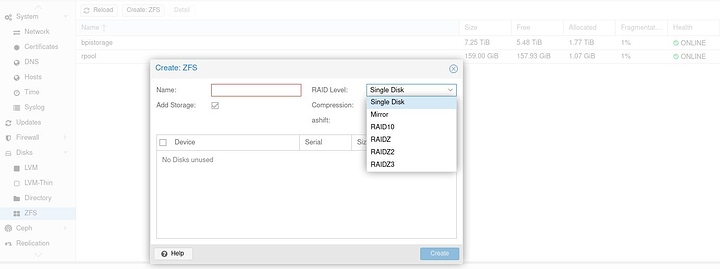There are lots of solutions that I would consider enterprise-grade, that are FOSS and very popular in the enterprise. Some of the most popular are TrueNAS Core, Proxmox, XCP-ng and “generic” KVM (oVirt or virt-man). For virtualization purposes, I only recommend the later 3. For just NAS and network file sharing, TrueNAS Core (unless you want to customize your own setup from the ground up). TrueNAS Core is great for what it does (being a NAS OS), especially if you are a home user.
Both TrueNAS Core and Proxmox have easy (too easy!) interfaces through which to configure ZFS pools
In the above, you would select disks. I didn’t do it through the GUI, because I had no idea if Proxmox would take the name assigned to the device (“sdX”), the name of the device (“ata-ST4000NM000A-…”), or the world wide name (“wwn-0x5000c500cd58…”). I preferred doing it through ZFS cli tools, because I wanted to make sure it uses the wwn and the pool stays the same even if I switch hardware. If I had any free disks, they would show up here.
The point is… both FreeNAS and Proxmox have easy GUI for management. But don’t rely on them. Use the CLI if you want to work in the domain in the future. For purely home use, they are good and extremely easy. I’m not sure about XCP-ng, but I don’t think XenOrchestra has GUI tools for ZFS (I could be wrong). But even if it did, I still recommend the CLI.


 And I won’t be living in this studio apartment for long anymore, will move all my equipment to my mom’s apartment and I’ll move to New Hampshire.
And I won’t be living in this studio apartment for long anymore, will move all my equipment to my mom’s apartment and I’ll move to New Hampshire.